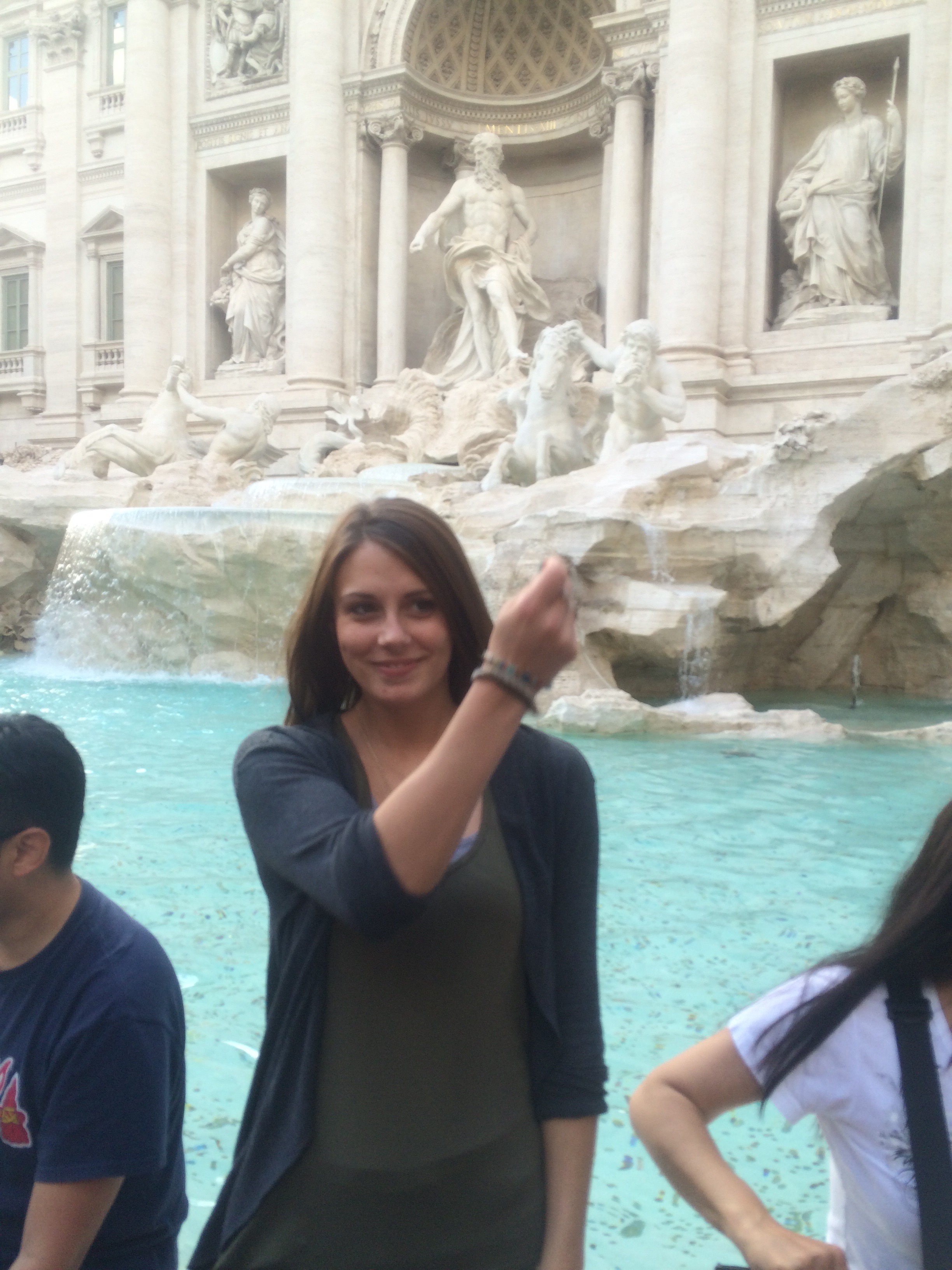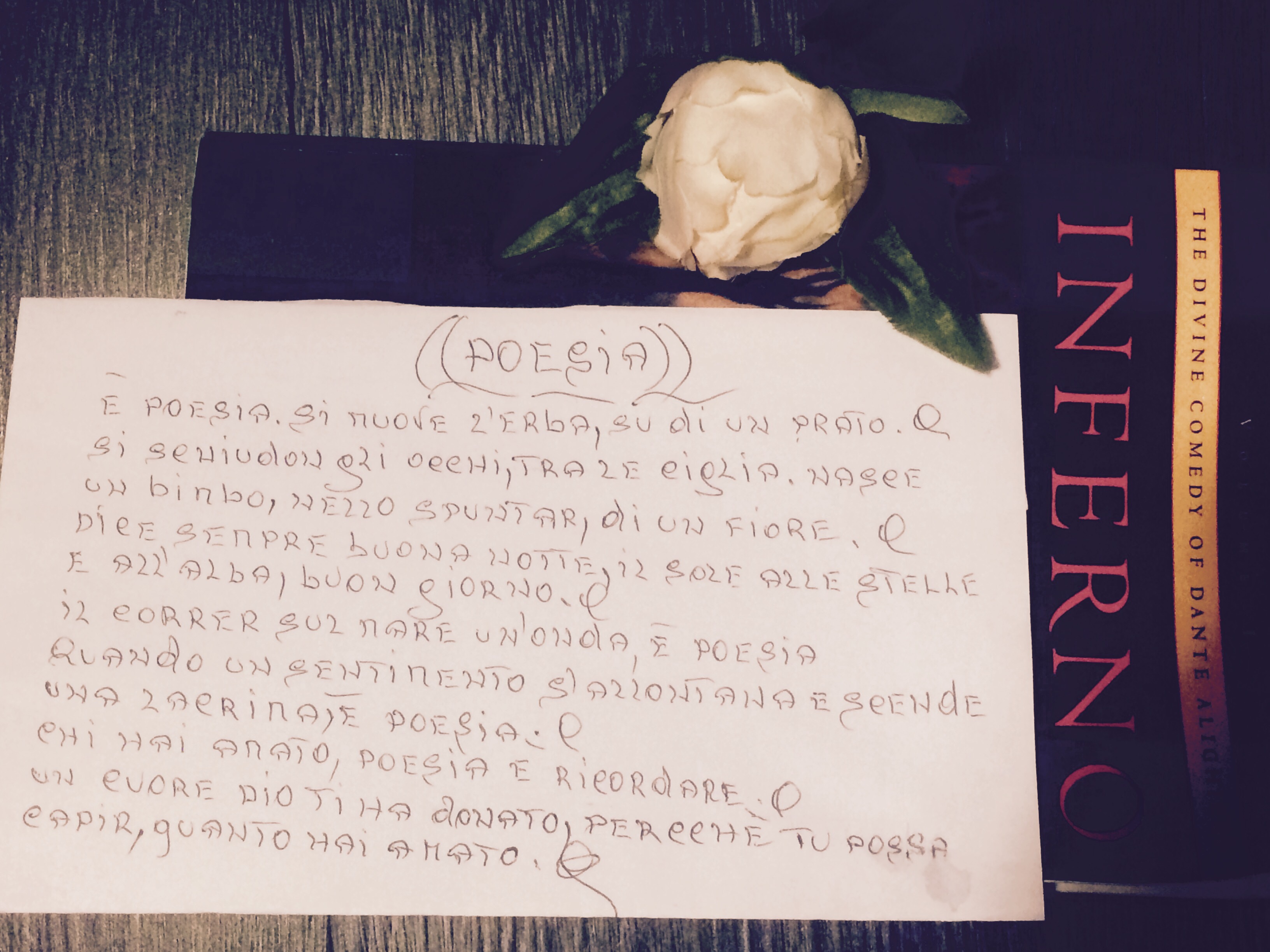Author: Casey Stevens
One by one each child dressed in a white robe with a white lily in hand marched in a single file line down the middle of the street. Parents and photographers lined the side walk with Canon cameras and iphone videos while the children smiled and mushed towards the church. I walked beside the proud parents as if I were a distant cousin to a family in the small town. I didn’t belong, and although people could sense I was an outsider, I still blended behind the mass –secretly hidden in every precious photo. There was one man, however, who called me out from the rest. After the crowd had disappeared in the church, I turned to walk back to the nunnery I was staying in, and that’s when he approached me. I was cradling my Inferno book as if it were my small child in need of protection. I held it close to my chest with the title facing out for all to see when an old, plump, white haired man chased me down the street. “Mi scusi, scusi” he said. When I stopped to make eye contact with him he pointed at my book with such enthusiasm. “Poeta! Poeta!” he repeated –pointing to the book and then to himself. “Mi poeta!” “Mi dispiace, non parlo italiano” is all I knew how to say. He smiled at me and laughed, but continued to point and repeat the word “poeta”. My friend, who was with me, flipped through her Italian phrase book for the word when it hit me that he was simply saying he, like Dante, was a poet. Strangely, he invited us into his house where poetry and drawings wallpapered the room. Letters were scattered along an end table, and a stack of papers were piled high in two towers on the kitchen table. The man was pleased. Before a minute had passed he turned on his stereo to a beautiful classical Italian instrumental, and he rummaged through one of the towers of paper. He pulled out a specific sheet and cleared his throat. When the music was just right, the man started to recite one of his poems. Although I couldn’t understand the worlds, he delivered it with such passion and emphasis. The music and the lyrics morphed together to create a beautiful Italian song. When the poem and the music stopped together, he smiled and handed me his poem to keep. He recited a few more poems with other instrumentals, and after several tracks, he handed my friends and I a fake rose for each of us before bidding us ado. We walked together –practically in tears because of the beautiful moment. This particular moment was my most memorable and favorite time. Despite the fact I couldn’t understand the man’s poetry, It was still beautiful to hear the Italian language roll of the tongue; and to think, this is all because this man spotted my copy of Dante’s Inferno; because poetry is more than just the...
For our free day, Amanda and I took a train to Verona from Florence to see Romeo and Giulietta’s balconies. The train ride was about 2 hours long, and we had about 6 hours between the arriving train and departing train. When we arrived to Verona, it was at least 10 degrees colder than Florence. The rain was pouring, the wind was strong, and we were lost 90% of the time, but that didn’t take away from magic of the city. Every time I cursed the rain and about the cold, I had to stop and remember that I was strolling down the same streets Romeo and Juliet would have walked; every time we got lost because there were no matching roadsides on the map, I reminded myself that I have the opportunity to be in Italy. This day trip not only made me appreciate Italy more, but it also made me appreciate, even more so, how much Shakespeare has influenced English literature and Verona culture. There were Shakespeare bars, Romeo and Giulietta cafés, tourist shops superficially dedicated to the tale, and of course, the Guilietta Club. The Giulietta Club is a club that accepts and reads tons of letters written to Juliet from people all of the world. They read the letters and can respond in Italian, English, Spanish, Arabic, and so many more. Fortunately, Amanda and I stumbled across the club in a dark ally way while we were lost, and of course, we had to write Juliet a letter! Out of all of the tourist places I’ve seen, I don’t think I have seen one quite as majestic as Juliet’s balcony. First, you walk into this short tunnel completely graffitied with hearts, names, and years –its so overwhelmingly beautiful. Then, you walk into this beautiful green courtyard –directly ahead there is gold statue of Giulietta and above her to the right is her balcony. The rain was cold and pelting the ground, but even so, my heart flutter, and like Michelangelo’s David, I saw Giulietta’s statue as a human being. Everyone one by one walked up to the gold figure and rubbed her breast for good love luck. Couples locked their “amore eterno” locks on chain links and door knockers, people stuck gum and notes to the wall behind her statue, and Amanda and I gazed up at the balcony is disbelief and awe –an absolute beautiful moment despite the miserable weather.
...Next to various works of art, Michelangelo’s David is one of the most well known Italian renaissance pieces of all time. The sculpture is seventeen feet tall, and was originally sculpted to be on top of Florence Cathedral. After Michelangelo sculpted the masterpiece, it was decided that the sculpture was too perfect to be on top of the building, and was instead placed inside a public square; then moved to Galleria dell’ Accademia. Personally, when I first laid eyes on the figure, I thought I was looking at an actual human being. His muscles and veins are anatomically accurate, and his figure is so smooth like a human body. His posture is so perfect that Michelangelo didn’t need to add more support than his David’s legs. Although some people believe this David is a representation of the biblical figure after he killed Goliath, his face, hand, and leg are reasons why I believe this was his stance seconds before he threw the stone. Michelangelo managed to capture the split second when the human heart is doubtful, but the brain triggers fight or flight. His face, his eyes, his mouth, and his brows all scream fear and doubt, but his body tells him he can do it –his brain reassures him of his ability to defeat the giant in front of him, and his veins and muscles pulsate with adrenaline. David’s right hand is forever in process of slowly grasping the stone, and his eyes are fixated on his target, Goliath. However, it is the left leg that is most important. David’s right leg is firmly planted flat whereas his left leg is positioned in a stepping form. His toes are firm on the ground whereas his heel is picked off of the ground and his knee is positioned inward –similarly to the stance before throwing a baseball. Michelangelo originally sculpted the David to reassure and protect Florence from invaders or wars, and thus, became this figure for Florence. For Michelangelo, David was a symbol of the fight between his renaissance ideas and the disapproval of the church. Regardless of the conflict or battle, David will always represent that moment we all experience: when we doubt ourselves and curse the situation, but our brains and our body thrust us towards the fight. It is the single moment when we decide to take our Goliath’s head on. P.S. There is a really cool ska song called “Toe to Toe” by Streetlight Manifesto about the battle between David and Goliath, and our battles with life obsticals, so that’s cool.
...The plane started to descend from the clouds of the sky, and from the tiny plastic window I could see the coast of Italy below like a detailed map unfolded across a table. Amanda and I held hands as we dropped closer and closer to the ground; trying to catch our breath from the excitement. Before long we were rushing through customs then to the bus, and then through Rome on the way to the hotel. It wasn’t until that bus ride did I feel like I had arrived. Even the airport and half of the bus ride felt like a foreign land to be me, but no different than if I traveled to Texas or Salt Lake City where the culture is different from Pennsylvania’s. Hell, even penile graffiti seems to be universal in Rome. It wasn’t the language barrier or the sudden change in fashion that made me realize where I was. When the bus pulled around the street corner to reveal the giant structures like the Coliseum, the Pantheon, and the Piazza Venezia was when I finally realized where I was, where I was going. Rome is a beautiful place; it is truly amazing. When I look at the ruins of ancient Rome and the Coliseum, I can’t help but try to create stories behind each crack, each missing puzzle. For example, during the tour of the Coliseum, our tour guide, Christina, mentioned that people weren’t suppose to eat during shows. However, when archeologist examined the waste system of ancient Coliseum they discovered peach seeds and cherry seeds, chicken bones, and other fossils hidden beneath the stone. It’s amazing to think that something so simple as breaking a rule and eating a peach in the stand would result in revealing historical information that would be otherwise lost. Maybe it’s because I’m not from Italy and I’m not use to the architecture, but I literally can’t compare any Italian buildings to something we have in America. The United States has beautiful buildings and scenery, but we don’t necessarily preserve them like Italy does. It’s mind boggling to me that a 2,000 year old amphitheater holds up better than any building we’ve had in the united states. Not that it’s a bad thing, but it makes me appreciate ancient romans and their ability to create something so strong and sturdy without the machinery we have today
... Pre-session Summer 2018
(May 16-May 30)
Pre-session Summer 2018
(May 16-May 30) 


